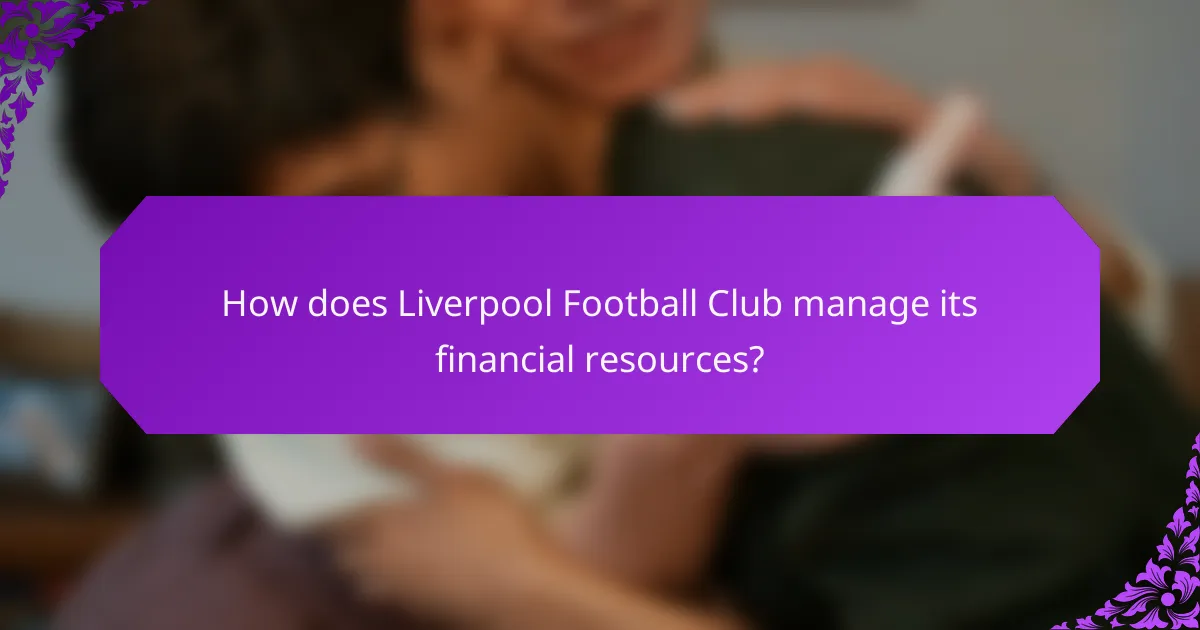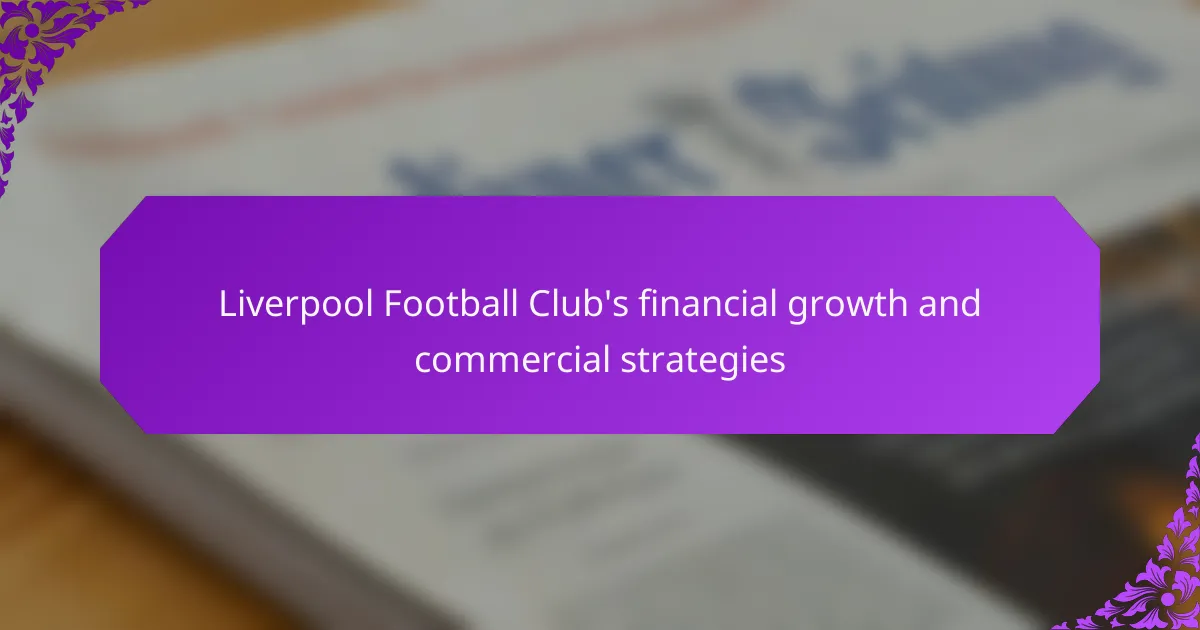Liverpool Football Club has achieved substantial financial growth through effective commercial strategies, including the expansion of its global fanbase and increased merchandise sales. In the 2021-2022 season, the club reported a revenue of £594 million, reflecting a 10% rise from the previous year. Key components of Liverpool’s financial strategy involve securing lucrative sponsorships, such as its partnership with Standard Chartered Bank, and investments in digital platforms to enhance fan engagement. The club’s financial management emphasizes a balance between revenue generation, cost control, and strategic investments, positioning Liverpool for continued growth in an increasingly competitive sports market.

What is Liverpool Football Club’s financial growth and commercial strategies?
Liverpool Football Club has experienced significant financial growth through various commercial strategies. The club has increased revenue streams by expanding its global fanbase. This includes enhancing merchandise sales and establishing international partnerships. In the 2021-2022 season, Liverpool reported a revenue of £594 million, showcasing a 10% increase from the previous year.
The club has also focused on securing lucrative sponsorship deals. Notably, its partnership with Standard Chartered Bank has been pivotal. Liverpool’s commercial strategy includes investments in digital platforms to engage fans worldwide. Additionally, the club’s success in competitions boosts its financial standing through prize money and increased ticket sales.
Overall, Liverpool’s strategic focus on global branding and fan engagement has contributed to its financial growth.
How has Liverpool Football Club’s financial growth evolved over the years?
Liverpool Football Club’s financial growth has significantly evolved over the years. In the early 2000s, the club faced financial difficulties, accumulating substantial debt. By 2010, the ownership changed, leading to improved financial management. The club’s revenue began to rise, particularly after the opening of Anfield’s new Main Stand in 2016. This expansion increased matchday revenue significantly. Additionally, commercial partnerships and sponsorship deals have grown, contributing to overall financial stability. For instance, Liverpool’s commercial revenue reached £233 million in 2021. The club’s success in domestic and European competitions has further boosted its financial standing. Overall, Liverpool’s financial growth reflects strategic investments and successful management decisions.
What key milestones have marked Liverpool’s financial growth?
Liverpool Football Club has experienced significant financial growth marked by several key milestones. The club’s revenue surged after winning the UEFA Champions League in 2019, generating approximately £60 million from the tournament. In 2020, Liverpool reported record revenues of £533 million, largely due to broadcasting rights and commercial deals. The successful expansion of the club’s global fanbase has also contributed to increased merchandise sales, reaching £50 million in 2021. The renovation of Anfield, completed in 2016, enhanced matchday revenues by increasing capacity and improving facilities. Additionally, the club’s strategic partnerships, such as the deal with Nike in 2020, further boosted its commercial income. These milestones demonstrate Liverpool’s effective financial strategies and growth trajectory in recent years.
How does Liverpool’s financial growth compare to other clubs?
Liverpool’s financial growth has been significant, positioning the club among the top earners in football. In the 2021-2022 season, Liverpool reported revenues of £594 million. This figure places them in the top five of the Deloitte Football Money League. Their growth rate has been driven by increased matchday revenues and lucrative commercial deals. Compared to rivals, Liverpool’s financial performance has outpaced many clubs in the Premier League. For instance, Manchester United reported £583 million in the same period. Additionally, Liverpool’s strategic focus on commercial partnerships has enhanced their financial standing. Their success in competitions also contributes to higher revenue streams. Overall, Liverpool’s financial growth is competitive within the European football landscape.
What commercial strategies has Liverpool Football Club implemented?
Liverpool Football Club has implemented several commercial strategies to enhance its financial growth. These strategies include global partnerships with major brands like Standard Chartered and Nike. The club has also focused on expanding its merchandise sales through online platforms and retail outlets. Liverpool has invested in digital content to engage fans worldwide, increasing brand visibility. The club’s matchday revenue has grown due to stadium expansions and improved fan experiences. Liverpool’s participation in international tours has further boosted its global fan base. Additionally, the club has leveraged social media to enhance fan engagement and attract sponsorships. These strategies have contributed to a significant increase in the club’s overall revenue.
What are the primary revenue streams for Liverpool Football Club?
Liverpool Football Club’s primary revenue streams include matchday revenue, broadcasting rights, and commercial partnerships. Matchday revenue comes from ticket sales, hospitality, and merchandise sold during home games. In the 2021-2022 season, matchday revenue reached approximately £66 million. Broadcasting rights account for a significant portion of income, with the club earning around £200 million from domestic and international television deals. Commercial partnerships generate revenue through sponsorships and merchandise sales, contributing approximately £50 million annually. These streams collectively support the club’s financial stability and growth.
How does Liverpool leverage sponsorship deals for financial growth?
Liverpool Football Club leverages sponsorship deals to enhance its financial growth through strategic partnerships. The club collaborates with global brands to secure significant revenue streams. These sponsorships include shirt deals, stadium naming rights, and commercial partnerships. For instance, Liverpool’s partnership with Standard Chartered generates substantial annual income. The club also engages in collaborations with companies like Nike, enhancing merchandise sales. In the 2020-2021 season, Liverpool reported sponsorship revenue exceeding £200 million. This financial strategy allows Liverpool to invest in player acquisitions and facilities. Overall, effective sponsorship management contributes significantly to the club’s overall financial stability and growth.
What role does fan engagement play in Liverpool’s financial strategies?
Fan engagement is crucial to Liverpool’s financial strategies. It enhances revenue through merchandise sales, ticket sales, and matchday experiences. High engagement leads to increased loyalty among supporters. This loyalty translates into higher spending on club-related products and services. Liverpool’s success in building a strong fan community boosts global brand visibility. The club has leveraged digital platforms to connect with fans worldwide. Social media interactions and content creation foster a sense of belonging. This strategy has resulted in significant sponsorship deals and partnerships. Overall, fan engagement directly contributes to Liverpool’s financial growth and stability.
How has Liverpool enhanced its fan engagement initiatives?
Liverpool has enhanced its fan engagement initiatives through various innovative strategies. The club has implemented a digital platform that allows fans to connect directly with players and staff. This platform includes live Q&A sessions, exclusive behind-the-scenes content, and interactive polls. Additionally, Liverpool has increased its presence on social media, engaging millions of followers with regular updates and fan-centric content. The club also hosts community events and fan meet-ups to strengthen local and global supporter connections. Recent statistics show a significant rise in fan interaction and satisfaction since these initiatives were launched.
What impact does fan engagement have on Liverpool’s revenue?
Fan engagement significantly boosts Liverpool’s revenue. High levels of engagement lead to increased merchandise sales. Engaged fans are more likely to attend matches, contributing to ticket sales. Enhanced fan interaction also attracts sponsorship deals. Liverpool’s social media presence has grown, increasing global reach and brand value. In the 2020-2021 season, Liverpool reported commercial revenue of £204 million, partly due to fan engagement strategies. Successful fan engagement initiatives include personalized experiences and loyalty programs. Overall, fan engagement is crucial for Liverpool’s financial sustainability and growth.

How does Liverpool Football Club manage its financial resources?
Liverpool Football Club manages its financial resources through a combination of revenue generation, cost control, and strategic investments. The club generates significant income from matchday revenues, broadcasting rights, and commercial partnerships. In the 2021-2022 season, Liverpool reported a revenue of £594 million, showcasing their strong financial performance. The club also focuses on controlling costs, particularly in player wages and transfer fees. Liverpool’s strategic investments in player development and infrastructure have further strengthened their financial position. The club’s successful commercial strategies include global sponsorship deals and merchandise sales, enhancing their brand value. Overall, Liverpool’s financial management is characterized by a balanced approach to income and expenditure.
What financial management practices are in place at Liverpool Football Club?
Liverpool Football Club employs various financial management practices to ensure fiscal responsibility and growth. The club utilizes a strict budgeting process to monitor income and expenditures. Financial forecasting is conducted to anticipate future revenues and costs. Liverpool also emphasizes revenue diversification through commercial partnerships and merchandise sales. The club regularly assesses its financial health using key performance indicators. Additionally, they maintain transparency with stakeholders regarding financial performance. These practices have contributed to Liverpool’s financial stability and growth in recent years.
How does Liverpool allocate its budget across different departments?
Liverpool Football Club allocates its budget across various departments based on strategic priorities. The primary areas of allocation include player wages, transfer fees, operational costs, and facilities maintenance. In the 2021-2022 season, Liverpool’s player wages accounted for approximately 60% of their total expenditure. Transfer fees are significant, with the club investing heavily in player acquisitions to enhance team performance. Operational costs cover day-to-day expenses, including staff salaries and matchday operations. Additionally, investment in facilities, such as the Anfield stadium, is crucial for long-term growth. The club’s financial reports detail these allocations, confirming the structured approach to budgeting across departments.
What measures does Liverpool take to ensure financial sustainability?
Liverpool Football Club ensures financial sustainability through various strategic measures. The club focuses on increasing matchday revenue by enhancing stadium facilities and experiences. Liverpool also invests in commercial partnerships to boost sponsorship income. The club prioritizes player development, promoting youth academy graduates to the first team. This approach reduces transfer costs while maintaining competitive performance. Additionally, Liverpool emphasizes prudent financial management, adhering to strict budgetary controls. The club’s successful participation in European competitions further enhances its financial stability through additional revenue streams. These measures collectively contribute to Liverpool’s long-term financial health.
How does Liverpool Football Club approach investments in player acquisitions?
Liverpool Football Club approaches investments in player acquisitions through a data-driven strategy. This strategy emphasizes analytics to assess player performance and potential. The club focuses on acquiring players who fit their tactical system and have resale value. Liverpool often targets younger players with high potential for growth. Financial sustainability is a key factor in their acquisition decisions. They aim to balance spending with revenue generated from player sales. The club’s successful recent acquisitions demonstrate this approach, including players like Diogo Jota and Luis Díaz. These investments align with Liverpool’s overall financial growth objectives.
What strategies does Liverpool use to maximize return on player investments?
Liverpool maximizes return on player investments through strategic scouting, player development, and smart transfer market activities. The club invests heavily in its academy to nurture young talent. This approach allows Liverpool to produce homegrown players who can either contribute to the first team or be sold for a profit.
Additionally, Liverpool employs data analytics to identify undervalued players in the transfer market. This method has led to successful signings, such as Mohamed Salah and Sadio Mané, who significantly increased their market value after joining the club.
The club also focuses on player performance optimization through coaching and sports science. This enhances the players’ skills and marketability. Finally, Liverpool maintains a strong brand presence, which increases the overall value of its players in the market.
How does Liverpool evaluate the financial impact of player transfers?
Liverpool evaluates the financial impact of player transfers through a comprehensive analysis of various financial metrics. This includes assessing transfer fees, player wages, and potential resale values. The club also considers the impact on merchandise sales and ticket revenue associated with new signings. Financial forecasting models are used to project future revenues and costs. Historical data on previous transfers helps to inform these evaluations. Additionally, Liverpool analyzes the market trends and player performance statistics to gauge investment risks. These methods ensure that the club makes informed decisions that align with its financial strategies.

What are the future prospects for Liverpool Football Club’s financial growth?
Liverpool Football Club’s financial growth prospects appear strong. The club’s recent success in domestic and European competitions boosts revenue streams. Increased matchday income is expected from the expansion of Anfield. Enhanced commercial partnerships and sponsorship deals contribute to financial stability. The club’s global fanbase drives merchandise sales and digital engagement. Liverpool’s strategic investments in player development promise future returns. Financial reports indicate a positive trend in profitability. The club’s management remains focused on sustainable growth strategies.
What upcoming opportunities could drive Liverpool’s financial growth?
Liverpool Football Club could experience financial growth through several upcoming opportunities. The expansion of their global fanbase presents a significant revenue potential. Increased merchandise sales and international tours can enhance brand visibility. The club’s participation in lucrative sponsorship deals is another avenue for financial enhancement. Enhanced digital engagement through streaming services can attract new subscribers. The development of the Anfield stadium will also create additional matchday revenue. Finally, success in domestic and European competitions can lead to increased prize money and broadcasting revenues. These opportunities collectively position Liverpool for substantial financial growth in the near future.
How might changes in broadcasting rights affect Liverpool’s finances?
Changes in broadcasting rights can significantly impact Liverpool’s finances. Increased broadcasting rights typically lead to higher revenue for clubs. For example, the Premier League’s broadcasting deals have been worth billions, benefiting all participating clubs. If Liverpool secures a more lucrative broadcasting agreement, their income from television rights could rise substantially. Conversely, a decline in broadcasting rights could reduce their financial resources. Historical data shows that Liverpool’s revenue from broadcasting was approximately £200 million in the 2020-2021 season. This revenue stream is crucial for funding player acquisitions, wages, and other operational costs. Therefore, fluctuations in broadcasting rights directly influence Liverpool’s overall financial health.
What role will digital transformation play in Liverpool’s commercial strategies?
Digital transformation will enhance Liverpool’s commercial strategies by improving operational efficiency and customer engagement. It enables the club to leverage data analytics for targeted marketing. Enhanced digital platforms will facilitate better fan interaction and experiences. This includes personalized content delivery through mobile apps and social media. Additionally, digital transformation supports e-commerce initiatives, increasing merchandise sales. Liverpool’s investment in technology will also streamline ticket sales and matchday operations. Overall, these advancements can lead to increased revenue streams and a stronger global brand presence.
What best practices can other clubs learn from Liverpool’s financial strategies?
Liverpool’s financial strategies emphasize sustainable growth through diverse revenue streams. The club has successfully increased matchday income by enhancing Anfield’s capacity and experience. This approach boosts ticket sales and fan engagement. Liverpool also prioritizes commercial partnerships, securing lucrative deals with global brands. The club’s focus on prudent player acquisitions and sales maximizes transfer market value. Their investment in youth development strengthens the squad while minimizing costs. Additionally, Liverpool’s financial transparency builds trust with fans and stakeholders. These practices collectively contribute to a robust financial model that other clubs can emulate.
How can clubs effectively balance commercial growth and sporting success?
Clubs can effectively balance commercial growth and sporting success by implementing strategic investments in both areas. This involves prioritizing youth development to cultivate talent while also enhancing the club’s brand value through global marketing initiatives. For example, Liverpool Football Club has focused on expanding its commercial partnerships, which has led to increased revenue. In the 2021 financial year, Liverpool reported a record revenue of £487 million, primarily due to commercial growth. At the same time, investing in player acquisitions and maintaining competitive performance in leagues ensures sporting success. The club’s success in securing a Champions League title in 2019 illustrates how commercial investments can align with on-field achievements. Additionally, engaging with fans through community programs and social media enhances loyalty, which in turn boosts both commercial and sporting outcomes.
What lessons can be drawn from Liverpool’s approach to financial management?
Liverpool’s approach to financial management emphasizes sustainability and strategic investment. The club focuses on balancing income and expenditure to avoid debt. They have invested in infrastructure, notably the expansion of Anfield, which enhances matchday revenue. Liverpool’s commercial partnerships are also a key factor, driving significant income growth. The club has successfully leveraged its global fanbase for merchandise sales. Financial prudence is evident in their player transfer policies, prioritizing value over high-profile signings. This approach has led to consistent profitability, with reported revenues exceeding £500 million in recent years. Overall, Liverpool exemplifies a model of financial responsibility and growth through strategic planning and investment.
Liverpool Football Club is the primary entity discussed, focusing on its financial growth and commercial strategies. The article outlines Liverpool’s significant revenue increase, reporting £594 million in the 2021-2022 season, driven by global fan engagement, merchandise sales, and lucrative sponsorship deals. Key milestones in the club’s financial evolution, including successful competition performances and infrastructure investments, are highlighted. Additionally, the article explores Liverpool’s strategic management of financial resources, emphasizing the importance of fan engagement and digital transformation in enhancing revenue streams. Overall, Liverpool’s approach serves as a model for sustainable financial practices in the sports industry.
